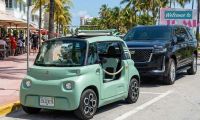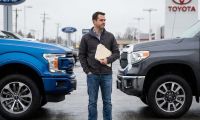“I’m not in the business of helping people Tweet better," David Strickland, head of the NHTSA was quoted as saying on a TheDetroitBureau.com June 9 posting by Paul A. Eisenstein, “ I’m not in the business of helping people post on Facebook better.”
Though there is a movement to provide online or broadcast feeds to people stopped at intersections, the major thrust of such telematics systems research is to use GPS positioning along with proximity and laser scanners to reduce collisions and congestion while providing more fuel and time-efficient routing, ultimately speeding assistance and emergency services to the scene when accidents do occur.
Here’s a related story on BMW’s research into telematics.
It is an accepted fact that talking on cell phones and certainly texting while driving are distractions easily comparable to inebriated driving and a danger to everyone on the road. Equally hazardous are the estimated one in five Americans who didn’t get enough sleep last night or the night before and yet are out driving on our highways half awake.
Still we can’t legislate sleep anymore than we can ratify social responsibility, but we can build cars that compensate for human imperfection. That is exactly what all the braking, traction and stability systems now common on many vehicles have done, making cars and thus drivers safer in the process.
The U.S. government is placing limits on what technologies can be used when in a car. Navigation screens cannot display movies, for example, when a vehicle is in motion. In most cases you have to pull over to use the navigator – that’s why voice command was developed and keeps improving. In addition, the use of handheld devices and texting while driving are prohibited in many states and municipalities.
Strickland and his boss, Transportation Secretary Ray LaHood, don’t think the government has gone far enough. Some would like to ban the use of even hands-free phone technology and severely limit other new technical features.
Safety, not profits, must be the first priority, the NHTSA chief stated. What he’s missing is much of the thrust of this kind systems development is completely about safety.
If simply talking to your navigator or Bluetooth phone is such a distraction, should we not outlaw passengers? After all, if they're in the car we might talk to them – perish the thought.
Ford is very much involved in this research.
While not specifically singling out automakers for criticism, he cautioned, “We will not take a backseat while new telematics and infotainment systems are introduced. There is too much potential for distraction of drivers.”
Ultimately, this technology will result in cars that drive themselves. Audi demonstrated such technology last year with a vehicle that maneuvered its way up and down Pikes Peak unassisted. Interestingly, a human-controlled helicopter covering the event collided with the ground somehow – the car performed perfectly.
Someday MADD will have to find some other human frailty to focus on, as the most intoxicated driver will simply enter the vehicle, proclaim, “Home, Jeeves,” and pass out as the car carries the happy or unhappy drunk safely home.
Sooner yet, cars will recognize erratic performance, pull themselves over, and notify the appropriate authorities for the apparent problem – whether medical, behavioral or chemical.
“I’m not going to dispute that people want these services,” Strickland said. “They do – especially the generation behind us. They’re used to being connected 24 hours a day.”
He added he doesn’t think cars need to be connected 24 hours a day. He’s just plain wrong. Try to convince the person who slid off I-70 in a blizzard down a long slope south of the interstate, completely out of sight in the blinding snow. Make anyone understand whose vehicle has broken down in a foreboding place they shouldn’t be connected – and good luck with that. It is about safety Mr. Strickland.
“I just don’t think the public is ready for that,” he said of self-driving automobiles.
Another recent post on TorqueNews, however, was in regard to the parents of teen drivers. The parents think teen accidents will be reduced by driver training, while the kids believe they will be ameliorated by technology. When autonomous cars are a reality, in say 20 years, these kids will be happy to let the car drive itself, allowing them to stay connected to their infotainment, video games, social media, work, friends and family.
Surely those cars can plot a path around the U.S. government, Ray LaHood and David Strickland.










Comments
I'm not sure that Mr.
Permalink
I'm not sure that Mr. Strickland even cares. I have been trying to get him to look at a danger that claims hundreds of lives a year. When a car goes into water deep enough that it is completely submerged and the windows fail in the up position, people are trapped because of the water pressure and they drown when the vehicle fills. We submitted an idea to re-shape the seatbelt slightly to enable it to break glass. Breaking glass to escape vehicle entrapment is the number one recognized solution to save lives. Emails to Mr. Strickland on this problem and the solution we call the Escape Tip are returned unopened.
Secretary LaHodd and
Permalink
Secretary LaHodd and Administrator Strickland are the best example of what we need in all of the Federal and States Governments. While most others ar pandering and looking to score a point in front of a camera, these two gentlemen are doing what they need to do to save lives and from the snide comments I hear when they are mentioned, no one knows how to say thank you.
Their predecessors burried reports that showed that dangers of cellular phones and driver distraction. They didn't do the same and instead of shoving the problem under the rug, they are out with full force promoting solutions to driver distraction. In the last two years they have accomplished more then what the last predecessors did in 16 years.
The authors is saying that Speech Recognition is improving. What about when Speech Recognition fails because it is not "improved" enough. What you call safety technology actually has less reliability then what's expected from a the bezel on your car stereo. They are not reliable and when they fail they are distracfting and if a drivers need to change navigation instruction, 5 minutes off the freeway is not going to kill them, but save their lives and others.
Cars and Drivers do not need to be connected 24/7. When that car slid off of I 70, yes, the system should have kicked in automatically then, but not before then. Actually, your excuse is as silly as this entire article. I did not see anywhere that Administrator Strickland said that we do not need the phone in emergencies like the one you mentioned.
Finally, Hands Free, Speech Recognition and Text To Speech are not Safety Technologies, but when they reach automotive reliability and are integrated with an Active Driver Distraction Mitigation System.